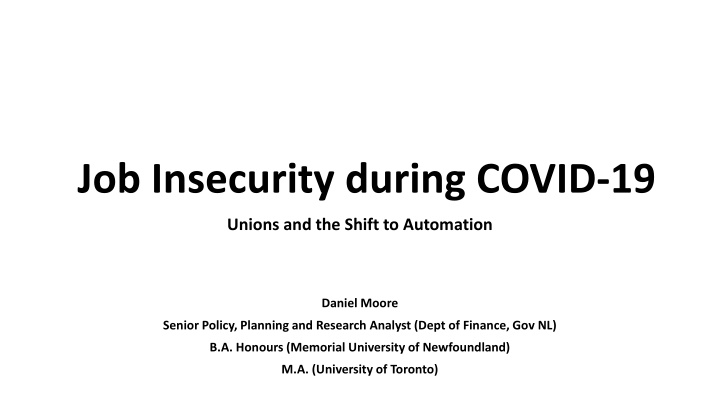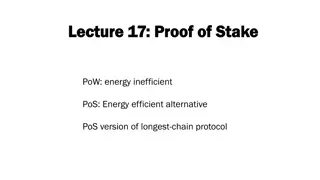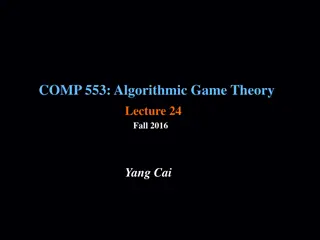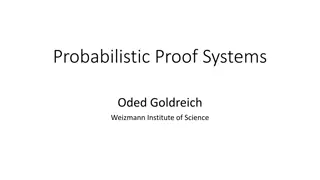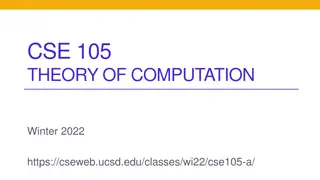Learning Goals and Proof Strategies in Theory of Computation
Today's learning focuses on distinguishing between NFAs and DFAs, understanding nondeterminism, designing NFAs for specific languages, and proving regular language properties. Explore strategies for constructing proofs in theoretical computer science.
Download Presentation

Please find below an Image/Link to download the presentation.
The content on the website is provided AS IS for your information and personal use only. It may not be sold, licensed, or shared on other websites without obtaining consent from the author.If you encounter any issues during the download, it is possible that the publisher has removed the file from their server.
You are allowed to download the files provided on this website for personal or commercial use, subject to the condition that they are used lawfully. All files are the property of their respective owners.
The content on the website is provided AS IS for your information and personal use only. It may not be sold, licensed, or shared on other websites without obtaining consent from the author.
E N D
Presentation Transcript
Job Insecurity during COVID-19 Unions and the Shift to Automation Daniel Moore Senior Policy, Planning and Research Analyst (Dept of Finance, Gov NL) B.A. Honours (Memorial University of Newfoundland) M.A. (University of Toronto)
The COVID-19 pandemic didnt affect everybody equally This paper analyzes the interaction between three phenomenon affecting low-wage workers. Employment by Educational Attainment Percent Change, April 2019 to April 2020, Atlantic Canada -1.6% University Education The first phenomenon, the recession related to the COVID-19 pandemic, disproportionately affected individuals without a university education. Postsecondary certificate or diploma -14.9% Employees moved towards telework in an effort to reduce the spread of the virus (Frenette and Frank, 2020). -18.8% No Postsecondary Education However, many low-income individuals worked in occupations which were difficult or impossible to perform remotely (Statistics Canada, 2021). -25% -20% -15% -10% -5% 0% Source: Author's Calculations based on Statistics Canada Table 14-10-0019-01
Technological innovation has disrupted the labour market The second phenomenon is the shift towards automation. Stock of Industrial Robots Canada, $ millions 1200 Technological innovation is complementary with highly educated workers, but substitutionary with low-skill workers performing routine tasks (Autor, 2015; Hershbein and Kahn, 2020). Robots for automotive assembly lines 1000 Industrial robots 800 50 to 70 percent of rising income inequality in the United States over the past 40 years can be explained by declining wages of workers in routine tasks that are easily automated (Acemoglu and Restrepo, 2021). 600 400 200 0 While the incomes of Americans with a high school diploma stagnated between 2010 and 2020, the number of industrial robots tripled (Bloom and Prettner, 2020). Source: Dixon (2020)
Classification of industries Classification Industry Jobs at Risk of Automation (%) Low Automation Information and Cultural Industries 2.8 Public Administration 3.7 Educational Services 4.2 Finance, insurance, real estate and rental and leasing 4.8 Other Services 5.6 Professional, Scientific, and Technical Services 7.2 Construction 8.4 High Automation Health Care and Social Assistance 12.0 Wholesale and Retail Trade 13.4 Transportation and Warehousing 14.5 Accommodation and Food Services 15.4 Manufacturing 26.6 Source: Frenette and Frank (2020)
Union membership is declining, especially in the goods sector Unionization Rate by Industry Atlantic Canada, percent The third phenomenon involves the benefits of unionization for low skill workers. 45% Unions have been shown to reduce income inequality. 40% 35% The union wage premium is greatest at the bottom of the income distribution as low-skill workers were the greatest beneficiaries of union membership (Callaway and Collins, 2017). 30% 25% Goods Sector Union membership strongly increases earnings for low-skill workers, but has a statistically insignificant impact on the earnings of high-skill workers (Brady, Baker, and Finnigan, 2013). Services Sector 20% Manufacturing 15% 2000 2015 1997 1998 1999 2001 2002 2003 2004 2005 2006 2007 2008 2009 2010 2011 2012 2013 2014 2016 2017 2018 2019 2020 2021 2022 Union membership has been declining in recent decades, especially in manufacturing. Source: Author's Calculations based on Statistics Canada Table Table: 14-10-0070-01
The Interaction of the three phenomenon Number of Employees by Industry Classification Canada, number of employees (thousands) The shift towards automation is episodic and accelerates during economic downturns (Jaimovich and Siu, 2020). 7,000 6,000 Job advertisements were more likely to contain educational requirements after the Great Recession (Hershbein and Kahn, 2020). 5,000 4,000 3,000 Orders for robots rose by 20 percent in Q1 2020 in North America (Lee, 2021). 2,000 This study uses microdata from Statistics Canada s Labour Force Survey to analyze: 1) how union membership affected employment during the pandemic, and 2) whether the effects of unionization were stronger in industries facing increased technological disruption. Unionized - High Automation Industries Unionized - Low Automation Industries 1,000 Not Unionized - High Automation Industries Not Unionized - Low Automation Industries 0 Sep-21 Jan-15 Jan-16 Jan-17 Jan-18 Jan-19 Jan-20 Jan-21 Jan-22 Jan-23 Sep-15 Sep-16 Sep-17 Sep-18 Sep-19 Sep-20 Sep-22 Sep-23 May-17 May-15 May-16 May-18 May-19 May-20 May-21 May-22 May-23 Source: Author's Calculations based on Statistics Canada Table 14-10-0069-01
Estimating Equation: Difference-in-Differences Model 1. Employment 7. Cluster Standard Errors =1 if the individual is employed and at work ??,?,?= ?0+ ????,?,?+ ?+ ?0,?+ ?0,?? + ??,?,? ??+ ??,?,? 6. Covariates 2. Difference-in-difference term. 3. Month fixed effects 4. Union membership fixed effects 5. Union membership- specific time trends Education Age Gender =1 if 1) the individual is a union member or is covered by a collective agreement AND 2) was surveyed in March 2020 or later Relaxes the common trends assumption
Diff-in-Diff Results: Employment by Industry Type 0.25 Unionization had roughly the same effect for workers in both high- and low-automation industries when using the full sample. 0.2 0.176*** 0.15 However, unionization was more effective in maintaining employment in high-automation industries when restricting the sample to data from January to April 2020. 0.1 0.095*** 0.088*** 0.078*** 0.05 0 High Automation Industries, +/- 2 months Low Automation Industries, +/- 4 months High Automation Industries, +/- 4 months Low Automation Industries, +/- 2 months
Estimating Equation: Triple Difference Model ??,?,?= ?0+ ?????,?,?+ ?+ ?0,?+ ??+ ??0,?+ ?0,???+ ?? ?+ ??,?,? ?1+ ??,?,? 2. Industry Fixed Effects and Interactions 1. Triple-Difference term. =1 if: 1) the individual is a union member or is covered by a collective agreement, 2) belongs to an automation-susceptible industry, AND 3) was surveyed in March 2020 or later
Triple Difference Results: Employment by Industry Type 0.4 0.3 When using the full sample, the effect of unionization on employment was not statistically different between high- and low- automation industries. 0.2 0.184*** However, the effect of union membership on employment was statistically stronger in high- automation industries in the early stages of the pandemic. 0.1 0.096* 0 -0.1 +/- 4 months +/- 2 months
Conclusion The results of this analysis are: 1) Union membership worked to increase employment during the COVID-19 pandemic. 2) Unions were very effective in curtailing employment losses in high automation industries in the early months of the pandemic, but this effect dissipated as the pandemic progressed. 3) The beneficial impacts of unions on employment persisted throughout the pandemic for low-automation industries. 4) It is possible that the bargaining power of unions in high-automation industries eroded as the pandemic progressed as employers shifted away from labour and towards other cost-saving methods. 5) The bargaining power of unions did not erode in low-automation industries as labour remained an important factor of production. 6) The policy implications of this analysis are that unions can effectively assist workers face the short-term consequences of the labour market disruptions caused by technological innovation.
References Autor, D.H. (2015). Why Are There Still So Many Jobs? The History and Future of Workplace Automation. The Journal of Economic Perspectives, 29(3), 3 30. Bloom, D., & Prettner, K. (2020). The macroeconomic effects of automation and the role of COVID-19 in reinforcing their dynamics. VOX CEPR Policy Portal, 25. Brady, D., Baker, R. S., & Finnigan, R. (2013). When unionization disappears: State-level unionization and working poverty in the United States. American Sociological Review, 78(5), 872-896. Callaway, B., & Collins, W. J. (2018). Unions, workers, and wages at the peak of the American labor movement. Explorations in Economic History, 68, 95-118 Dixon, J. (2020). The Employment Consequences of Robots: Firm-Level Evidence. Statistics Canada= Statistique Canada. Frenette, M., & Frank, K. (2020). Automation and Job Transformation in Canada: Who's at Risk?. Statistics Canada= Statistique Canada.
References Hershbein, B., & Kahn, L. B. (2018). Do recessions accelerate routine-biased technological change? Evidence from vacancy postings. American Economic Review, 108(7), 1737-72. Jaimovich, N., & Siu, H. E. (2020). Job polarization and jobless recoveries. Review of Economics and Statistics, 102(1), 129-147. Lee, D. (2020). As Covid-19 wanes, employers are accelerating the use of robots. Where does that leave workers? Los Angeles Times. Statistics Canada. (2021). COVID-19 in Canada: A One-year Update on Social and Economic Impacts. A Presentation Series from Statistics Canada About the Economy, Environment and Society. 11- 631-X.
